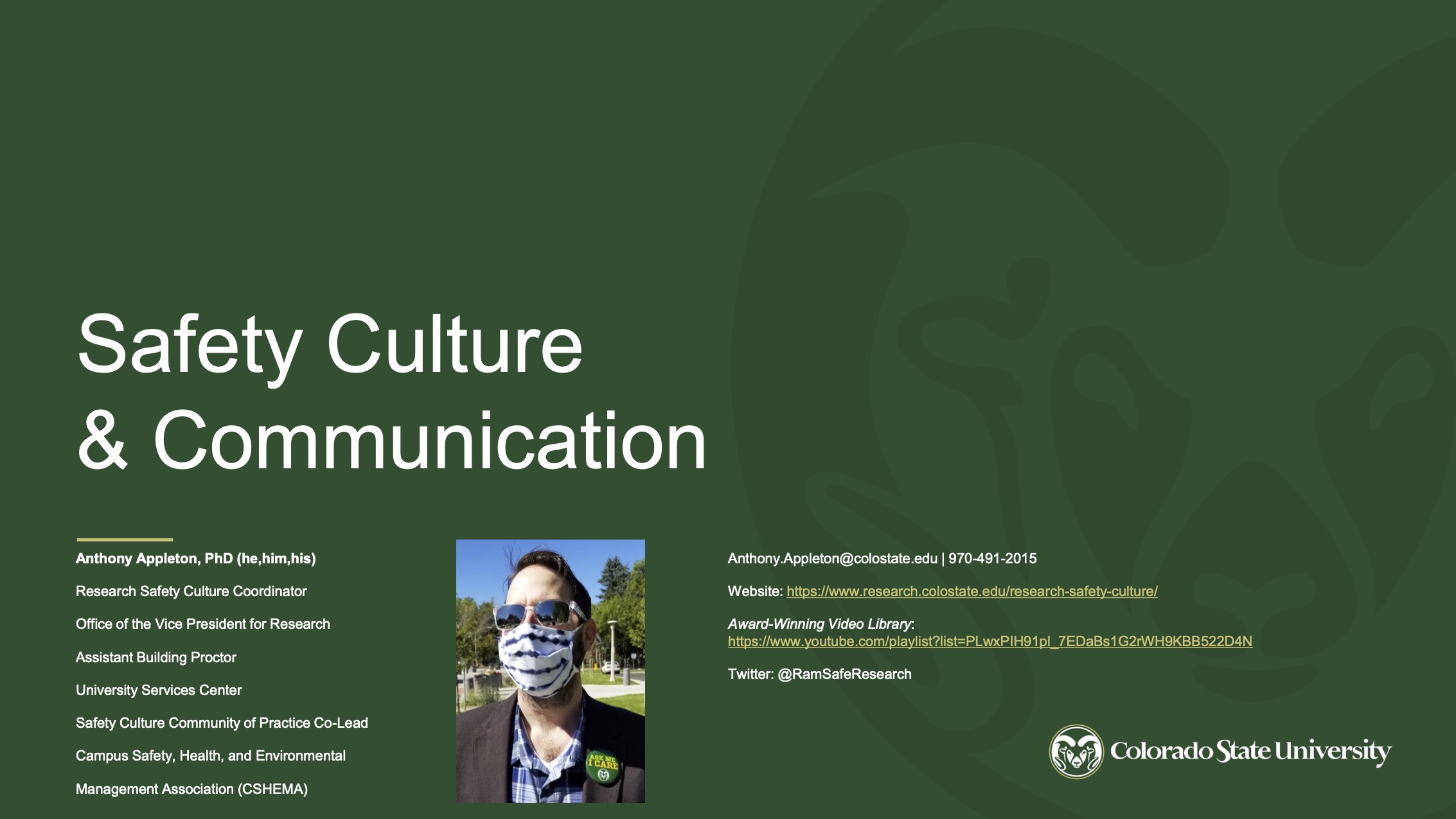Led by:
Dr. Anthony Appleton
Colorado State University
Resources discussed in the talk:
- Colorado State University Research Safety Culture Website: https://www.research.colostate.edu/research-safety-culture/
- A Performance Audit of the University of Utah’s Laboratory Safety Practices by the Office of the Legislative Auditor General in the State of Utah: https://le.utah.gov/audit/19_06rpt.pdf
- “The University of Utah’s lab safety system is ‘broken,’ audit says” in C&EN: https://cen.acs.org/safety/lab-safety/University-Utahs-lab-safety-system/97/i20
Dr. Anthony Appleton’s introductory talk
- Love languages: learning about these can help you communicate better with different types of people
- Think about who you learned research from and how that influenced how you do it
- I learned from key mentors:
- Communication was one of the most important things about research
- The importance of building relationships in the safety sphere
- I learned how the building operated and how that impacted the other workers in the building
- At Stanford University, my lab moved to a new building. I had to learn how to interact with the Fire Department, city officials, architects, and had to manage chemical inventory.
- Generation Accident: An important question that needed to be considered after the death of Sheri Sangji – who calls her parents?
- Researchers are on the front lines; the Executive Capacity don’t necessarily know how to help you in the best way – and you may not know how to communicate with them.
- At CSU, was seeking to answer: Who do you talk to? How do you do it?
- Recognized that someone needs to translate between the researchers and those who should be supporting them
- Now have Safety Teams organized with faculty or staff AND graduate students – currently organized into MS Teams and hold monthly meetings to communicate with one another
General Conversation
- Question: How did you find your acceptance at the lab level when coming into this new position at CSU?
- Answer: Everyone read my title and thought “he’s the safety guy.” They thought it was another compliance unit and they brushed me off. To overcome this, I reached out to meet with people in relaxed situations (e.g. over coffee) and said, “Let’s talk. What can I do to help you? And I can’t get you into trouble.” Also, I answer directly to a VP. In discussing safety culture, I also realized I needed to explain to people that safety is an expansive concept that goes far beyond chemical compliance (e.g. sexual harassment, construction).
- Question: Do you have any suggestions from your experience for fostering safety at the undergraduate level?
- Answer: When exploring improving undergraduate labs, realized that each lab class functioned as a silo. No one wanted anything added to their curriculum. Now working on a project focused on teaching labs generally.
- Pay attention to where your student go. For CSU, #2 destination state is California, so we are working to incorporate education on Cal OSHA.
- Trying to work on updating classical classes. Realize that people have worked on this curriculum for years so it can be tough to walk in and say “hey, you are missing something from your curriculum.”
- CPT is working on next set of safety guidelines for undergraduates.
- When working to shift safety culture, snag new faculty before anyone else and start with examining your onboarding process. Everyone says they hate their onboarding – find out why and fix that.
- I can’t walk into every research environment and command respect – but I can walk in with a specialist who can.
- All researchers need help – and when they figure out you’re not going to ding them for it and that you are actually going to help, they are much more open.
- At CSU, we designed a single website that puts contacts and safety info in one place: https://www.research.colostate.edu/research-safety-culture/
- When you feel appreciated, you give back to your school.
- Check out the University of Utah report in order to see how the responsibilities of Executives has now been defined by a governmental body.
- Question: Who is predisposed to be a champion? How do you find those 1st people?
- Answer: That’s in the conversations. Start talking to committees. See who they identify and respect as the true powerhouses. This will take some digging. Meet those people casually and one-on-one (i.e. don’t meet in the office or in front of senior management of the university).


Effective safety culture and communication are vital in research environments. Resources from Colorado State University’s Safety Culture website and the University of Utah’s lab safety audit highlight the importance of translating safety needs between researchers and support staff. Building relationships, casual meetings, and understanding local compliance are key strategies.